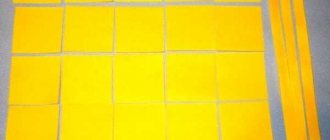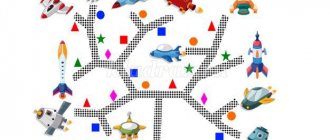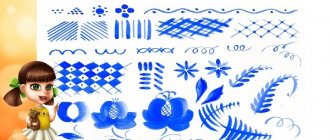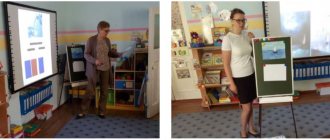Let's go on a journey through the stations
Then the children can be invited to go on an exciting journey, during which they will be able to gain multifaceted knowledge about bread.
The first station is “Answers to Questions.” Now let's see how carefully you watched the cartoon and whether you can answer my questions.
— Bread can be different, but it is always healthy and tasty. It contains vitamin B, which helps strengthen the nervous system and memory. Where do we get bread? - We buy it at the store. - What is it made from? — From flour — What is flour made from? — From grains
— Machines help people grow and harvest ears of corn. In spring, a tractor goes out into the field. Who is leading it? - Tractor driver - Well done guys, and now we’re going to the second station “Fizkultminutka”.
The tractor pulls an iron plow that plows the ground. Once the soil has become loose, you can begin to sow! Special devices are attached to the tractor - seeders, which sow wheat grains into the soil. The wheat has sprouted and ripened throughout the summer. Let us become the little grains that were sown in the field.
Physical school
A grain fell into the ground, (squat down) It began to sprout in the sun (hands above your head) The rain watered the ground, And the sprout grew (slowly stand up) It reached out to the light and warmth And turned into a handsome man. (2 times)
— We rested a little, and now we’re going again to the “Interrogative” station, where you need to answer a few more questions about bread. — When the harvest begins, what machines collect the ears? — Combines — The collected threshed grains are delivered to elevators, where they are stored. Where should the grains go next? - To the mill - There the grain turns into flour, and then the flour goes to... - Bakery, bakery...
Logorhythmic lesson on the topic “Where did the bread come from”
[Enter text]
Abstract of an open lesson on logorhythmics for a conference on modern methods in the training and education of preschool children
| Organizational information | ||
| Author of the lesson | Khristoforova Svetlana Vasilievna | |
| Item | Logorhythmics | |
| Class, class profile/group, number of people | Middle kindergarten group. Subgroup lesson: 5 people | |
| Duration of the lesson (class) | 20 minutes | |
| Methodological information | ||
| Topic of the lesson/lesson/event | "Where did the bread come from" | |
| Author of the textbook or teaching materials used to teach (if available) | ||
| Classification of a lesson/session/event in the system of educational events (type, relationship with previous and subsequent lessons/sessions/events) | Combined lesson | |
| Psychological and pedagogical characteristics of features class/team/group | Children attend logorhythmics classes throughout the entire school year (7 months). Children of this group have normal intellectual and speech development, are active and inquisitive. They do not have clearly defined behavioral and emotional-personal characteristics. | |
| Objectives of the lesson/activity/event | Prevention and correction of non-speech disorders in the motor and sensory areas, speech development in general | |
| Objectives of the lesson/activity/event | Wellness: Strengthening the musculoskeletal system, developing breathing, developing correct posture, improving coordination of movements. Educational: Formation of motor skills and abilities, development of switchability, coordination of movements. Correctional and developmental: development of speech hearing, attention, articulatory and fine motor skills, facial muscles. Educational objectives: developing a sense of rhythm, the ability to sense rhythmic expressiveness in music Preliminary work: Learning the poems “Happy, Golden”, “Scented Bread” | |
| Knowledge, abilities, skills and qualities that will be updated/acquired/consolidated/etc. students/staff during a lesson/activity/event | Cognitive: Gaining knowledge on the topic “Where does bread come from.” Regulatory The ability to complete the task assigned by the teacher within the allotted time without being distracted. Communicative: The ability to wait for each other, monitor other children’s performance of exercises and movements and correct their own. | |
| Educational material to be mastered, updated, consolidated | Poems about bread. Rhythmic movements. | |
Lesson plan
- Organizing time.
Tasks
:
Get the children ready to start the lesson.
The song “Come on, everyone, stand in a circle” plays.
Text:
Come on, everyone, stand in a circle.
Everyone suddenly held hands (We walk in a circle, holding hands)
We will stand next to each other and wave our arms (We stop and wave our arms)
Let's start practicing (Clap our hands)
We will try our best throughout the lesson (stomp our feet)
Repeat, don’t yawn, remember everything” (Hands on the belt - spin left and right)
Repeat 2 times
- Walking and marching
Tasks
: formation of walking skills, adherence to a given direction, movement according to landmarks, ability to perform imitative movements.
Children walk to different music:
-on the outside of the foot (representing bear cubs), the melody “Bears” sounds
-on the inside of the foot (representing ducklings), the melody “Ducklings” sounds
- raising your knees high (representing horses), the melody “Horses” sounds
3) Music game:
Tasks
: Development of auditory attention, ability to correlate music and movements, development of coordination of movements.
The teacher plays the melody “Bears”, “Ducks”, “Horses” in turn, without naming it or showing the movement. Children must guess what kind of melody it sounds and determine what movement should be performed to this music.
- Introduction to a new topic. "Where did the bread come from?"
Guys, today we have real bread as our guest at our Logorhythmics lesson! Look what he is like! Fragrant, rosy, very tasty and healthy!
Did you know that before this delicious bread appears on our table, many people need to work hard.
First you need to plow the field. By tractor. Remove weeds, loosen the soil and level it.
Then you need to sow grain in this land. Grain growers on tractors sow grain.
After this, you need to wait until the wheat grows. See how it has grown.
Now, it's time to harvest the wheat from the field. Combine operators go to work and harvest the crops.
And then together we will show and tell our guests what will happen next.
- Exercise-round dance “Golden having fun.”
Having fun, gilded There is wheat in the backs of cars. (Children walk in a round dance) Golden grains (Depict grains - palms connected above the head) Roasting in the sun Ride the grains in the back (Movements with arms bent at the elbows on the side) Yes, spin in the millstones, (Movements with arms bent at the elbows in front of you) Warm up in the stove , (They spin around themselves in one direction and the other) So that later they can come to our house like a Flatbread. (Hands show a round flatbread) With a shiny, tasty and crispy crust. (They walk in a round dance)
Now we know where the bread on our table comes from
- Ri.
Tasks
: Development of a sense of rhythm, coordination of movements, imitative movements, development of fine motor skills.
Here it is, the fragrant bread, here it is warm, golden. (Rhythmic clapping of hands, then fists) He came to every house, to every table. (Rhythmic clapping alternately - right fist + left palm and vice versa) It contains our health, strength, and wonderful warmth. (Rhythmic clapping of knees with palms and fists) How many hands raised him, protected him, took care of him. (Rhythmic claps on the knees alternately with the right fist + left palm and vice versa) It contains the earth’s native juices, (Clapping hands + claps on the knees) The sun has a cheerful light in it... Grasp both cheeks, grow up to be a hero! (Cross claps on knees)
- Game “Trucks carrying bread to the store”
Tasks
: Development of gross motor skills, coordination of movements, sense of balance.
Teacher: “Guys, let’s imagine that a lot of bread was baked at the factory, and it needs to be taken to the store. You turn into a truck that must carry bread in its back without dropping it. It must be transported carefully, neatly, like a real treasure.”
Rubber (plastic) bread is placed on the children's back, and they must walk along the path on all fours without dropping it on the floor. If you drop it, you need to pick it up, put it back and deliver it to its place.
- Articulation, facial expression, breathing exercises.
Tasks
: Development of articulatory motor skills, facial muscles, speech breathing.
- Hamster
- Delicious jam
- Pleasant smell of bread
- Mom baked a loaf
- Mom frowns
- Let's fall asleep
- Summing up the lesson.
Tasks
: summing up, speech development.
Teacher: We played a lot today. What were many of our games and exercises about? The teacher asks each child which exercise he liked or didn’t like. What was difficult or easy.
- Final relaxation exercise “Butterflies”.
Tasks
: Relaxation, relaxation.
The music "Butterfly" plays. Children flutter over a field of wheat, slowly raising and lowering their arms. At the end of the music, they “fly away” from the hall.
1
Station “Creative” and completion of the lesson
Next, you can offer children either a didactic game with colorful materials, or bring a bread machine from home (if possible), show what ingredients are used for baking besides flour, and how this process occurs. Or you can make baked goods from salted dough, and you can offer children different options - flat cakes, loaves, horns and other types.
In conclusion, name the proverbs that the children memorized as part of the preliminary work for this lesson. If this has not been done before, then you can discuss the proverbs together.
“Bread is the head of everything.” “Better bread and water than pie with misfortune.” “Bread is father, water is mother.” “It’s a bad lunch if there’s no bread.” “You should always finish your bread.”
Then summarize what you have learned. For parents, organize an exhibition of salt dough bread.
I can also suggest incorporating the following ideas into the lesson:
- talk about how they used to call for rain for a good harvest, how they collected ears of corn by hand;
- talk about the tradition of greeting guests with bread and salt, baking a beautiful loaf;
- invite children to draw up a drawing diagram “Where did the bread come from?”;
- play the game “Agricultural Equipment”, offering each student a set of machines that must be placed in the correct sequence according to the harvesting process.
My dear colleagues, I think that you will add your interesting additions to the lesson in the comments. I will be very grateful. In the meantime, don’t forget to like the article and subscribe to blog updates if you haven’t done so before. Thank you for your attention!
Sincerely, Tatyana Sukhikh! Till tomorrow!







